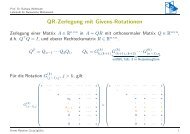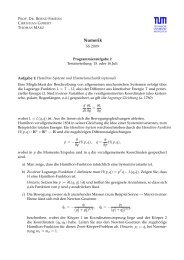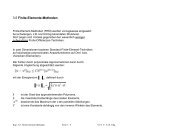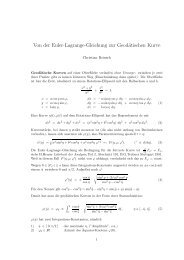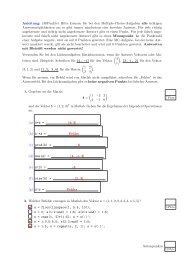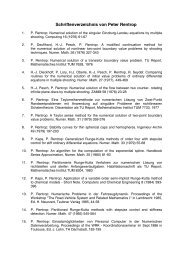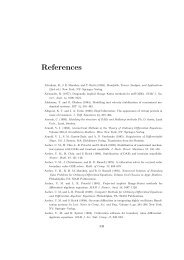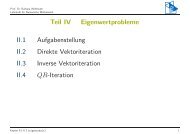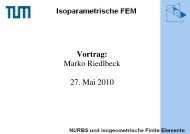Create successful ePaper yourself
Turn your PDF publications into a flip-book with our unique Google optimized e-Paper software.
Tensor networks, TT (Matrix Product States)<br />
and Hierarchical Tucker decomposition<br />
R. Schneider (TUB Matheon)<br />
John von Neumann <strong>Lecture</strong> – TU Munich, 2012
Setting - Tensors<br />
Vν := R n , H d = H :=<br />
d�<br />
Vν d-fold tensor product Hilbert-s.,<br />
ν=1<br />
H � {(x1, . . . , x d) ↦→ U(x1, . . . , x d) ∈ R : x i = 1, . . . , n i} .<br />
The function U ∈ H will be called an order d-tensor.<br />
For notational simplicity, we often consider n i = n. Here<br />
x1, . . . , x d ∈ {1, . . . , n} will be called variables or indices.<br />
k ↦→ U(k1, . . . , k d) = (U k1,...,k d ) , k i = 1 . . . , n i .<br />
Or in index (vectorial) notation<br />
U = � U k1,...,k d<br />
� ni<br />
k i =0,1≤i≤d<br />
dim H = n d curse of dimensions!!!<br />
E.g. wave function Ψ(r1, s1, . . . , r N, s N)
Contracted tensor representations<br />
Espig & Hackbusch & Handschuh & S.<br />
Let Vν := R rν<br />
K K = K :=<br />
K�<br />
Vν d-fold tensor product space,<br />
ν=1<br />
K � {(k1, . . . , k K ) ↦→ V (k1, . . . , k K ) : k i = 1, . . . , r i} .<br />
Here k1, . . . , k N will be called contraction variables,<br />
x1, . . . , x d will be called exterior variables.<br />
We define an order d + K tensor product space<br />
�H := H ⊗ K � {(x1, . . . x d, k1, . . . , k K ) ↦→ � U(x1, . . . , x d, k1, . . . , k K ) :<br />
x i = 1, . . . , n; 1 ≤ i ≤ d, k j = 1, . . . , r j, 1 ≤ j ≤ K } .
Contracted tensor representations<br />
Definition<br />
Subset Vr ⊆ H: Let d < d ′ ≤ d + K ,<br />
U ∈ V r r1� rK� d<br />
⇔ U = . . .<br />
′<br />
�<br />
k1<br />
k K<br />
ν=1<br />
where k ν(i) ∈ {k1, . . . , k K }, i = 1, 2, 3, and<br />
uν(xν, k ν(1), k ν(2)) if ν = 1, . . . , d<br />
uν(xν, k ν(1), k ν(2), k ν(3))<br />
uν(k ν(1), k ν(2), k ν(3)) if ν = d + 1, . . . , d ′ ,<br />
I.e. the d ′ tensors uν(., ., .) depends at most on 3 variables!<br />
We will write shortly uν(xν, kν) ∈ R, keeping in mind that uν<br />
depends only on at most three variables xν, k ν(1), k ν(2),k ν(3).<br />
Example<br />
Canonical format: K = 1, d ′ = d, uν(xν, k), k = 1, . . . , r.
Contracted tensor representations<br />
Definition<br />
Subset Vr ⊆ H: Let d < d ′ ≤ d + K ,<br />
U ∈ V r r1� rK� d<br />
⇔ U = . . .<br />
′<br />
�<br />
uν(xν, kν(1), kν(2), (kν(3))) k1<br />
k K<br />
ν=1<br />
the d ′ tensors uν(., ., .) depends at most on 3 variables! (Not<br />
necessary!)<br />
Complexity:<br />
Let r := max{r i : i = 1, . . . , K } then storage requirement is<br />
♯DOF ′ s ≤ max{d ′ × n × r 2 , d ′ × r 3 } .
Contracted tensor representations<br />
◮ Due to the multi-linear ansatz, the present extremely<br />
general format allow differentiation and local optimization<br />
methods! (See e.g. previous talk!)<br />
◮ Redundancy has not been removed, in general<br />
redundancy is enlarged.<br />
◮ Closedness would be violated in general.<br />
Tensor networks<br />
Definition<br />
A minimal tensor network is a representation in the above<br />
format, where each contraction variable k i, i = 1, . . . , K , appear<br />
exactly twice. In this case, they can be labeled by i ∼ (ν, µ),<br />
1 ≤ ν ≤ d ′ , 1 ≤ µ < ν. It is often assumed, that each exterior<br />
variable x i appear at most once!
Tensor networks<br />
Diagramm:<br />
u [x]<br />
Diagram - (Graph) of a tensor network:<br />
vector matrix tensor<br />
x x x<br />
1 2<br />
x 1<br />
u [x 1 , x 2 ]<br />
=<br />
u 1 [x 1, k]<br />
k<br />
x 2<br />
x 1<br />
k 2<br />
x 1<br />
u [x 1 , ... , x 8 ]<br />
u 2 u 4 [x 4 , k 3 , k 4 ]<br />
x 1<br />
=<br />
=<br />
k<br />
i<br />
x 8<br />
TT format<br />
HT format<br />
◮ Each node corresponds to a factor uν, ν = 1, . . . , d ′ ,<br />
◮ each line to a variable xν or a contraction variable kµ.<br />
◮ Since kν is an edge connecting 2 tensors uµ1<br />
has to sum over connecting lines (edges).<br />
and uµ2 , one
Tensor networks has been introduced in quantum information<br />
theory.<br />
Example<br />
1. TT (tensor trains, Oseledets & Tyrtyshnikov ) and HT<br />
(Hackbusch & Kühn) formats are tensor networks.<br />
2. the canonical format is not (directly) a tensor network.<br />
x 1<br />
k 1<br />
tensor networks<br />
ki<br />
x 1<br />
closed tensor<br />
network<br />
tensor networks<br />
u 2 [x k i k j ]<br />
2
Tensor formats<br />
⊲ Hierarchical Tucker format<br />
(HT; Hackbusch/Kühn, Grasedyck, Kressner : Tree-tensor networks)
Tensor formats<br />
⊲ Hierarchical Tucker format<br />
(HT; Hackbusch/Kühn, Grasedyck, Kressner : Tree-tensor networks)<br />
⊲ Tucker format (Q: MCTDH(F))<br />
U(x1, .., x d) =<br />
{1,2,3,4,5}<br />
1 2 3 4<br />
5<br />
r1�<br />
. . .<br />
k1=1<br />
r d�<br />
k d =1<br />
B(k1, .., k d)<br />
d�<br />
Ui(ki, xi) i=1
Tensor formats<br />
⊲ Hierarchical Tucker format<br />
(HT; Hackbusch/Kühn, Grasedyck, Kressner : Tree-tensor networks)<br />
⊲ Tucker format (Q: MCTDH(F))<br />
⊲ Tensor Train (TT-)format<br />
(Oseledets/Tyrtyshnikov, � MPS-format of quantum physics)<br />
U(x) =<br />
{1,2,3,4,5}<br />
r1�<br />
. . .<br />
k1=1<br />
{1} {2,3,4,5}<br />
{2} {3,4,5}<br />
{3}<br />
{4}<br />
r d−1<br />
�<br />
kd−1=1 i=1<br />
{4,5}<br />
{5}<br />
d�<br />
Bi(ki−1, xi, ki) = B1(x1) · · · Bd(xd) U 1 U 2 U 3 U 4 U 5<br />
r 1 r 2 r 3 r 4<br />
n 1 n 2 n 3 n 4 n 5
Noteable special case of HT:<br />
TT format (Oseledets & Tyrtyshnikov, 2009)<br />
(matrix product states (MPS), Vidal 2003, Schöllwock et al.)<br />
TT tensor U can be written as matrix product form<br />
=<br />
r1�<br />
..<br />
k1=1<br />
rd−1 �<br />
kd−1=1<br />
U(x) = U1(x1) · · · U i(x i) · · · U d(x d)<br />
U1(x1, k1)U2(k1, x1, k2)...Ud−1(kd−2xd−1, kd−1)Ud(kd−1, xd, kd)<br />
with matrices U i(x i) = � u k i<br />
k i−1 (x i) � ∈ R r i−1×r i , r0 = r d := 1<br />
U 1 U 2 U 3 U 4 U 5<br />
r 1 r 2 r 3 r 4<br />
n 1 n 2 n 3 n 4 n 5<br />
Redundancy: U(x) = U1(x1)GG −1 U2(x2) · · · U i(x i) · · · U d(x d) .
TT approximations of Friedman data sets<br />
f2(x1, x2, x3, x4) =<br />
�<br />
(x 2 1 + (x2x3 − 1<br />
)<br />
x2x4<br />
2 ,<br />
f3(x1, x2, x3, x4) = tan −1 � x2x3 − (x2x4) −1 �<br />
on 4 − D grid, n points per dim. � n 4 tensor, n ∈ {3, . . . , 50}.<br />
full to tt (Oseledets, successive SVDs)<br />
and MALS (with A = I) (Holtz & Rohwedder & S.)<br />
x1
Solution of −∆U = b<br />
◮ Dimension d = 4, . . . , 128 varying<br />
◮ Gridsize n = 10<br />
◮ Right-hand-side b of rank 1<br />
◮ Solution U has rank 13
Hierarchical Tucker as subspace approximation<br />
1) D = {1, . . . , d}, tensor space V = �<br />
j∈D V j<br />
2) T D dimension partition tree, vertices α ∈ T D are subsets<br />
α ⊂ T D, root: α = D<br />
3) Vα = �<br />
j∈α V j for α ∈ T D<br />
4) Uα ⊂ Vα subspaces of dimension rα with the characteristic<br />
nesting<br />
Uα ⊂ Uα1 ⊗ Uα2 (α1,<br />
5) v ∈ U D (w.l.o.g. U D = span (v)).<br />
α2 sons of α)
Subspace approximation: formulation with bases<br />
Uα = span {b (α)<br />
i<br />
b (α)<br />
ℓ<br />
=<br />
i=1 j=1<br />
: 1 ≤ i ≤ rα}<br />
rα rα<br />
�1<br />
�2<br />
c (α,ℓ)<br />
ij b (α1)<br />
i ⊗ b (α2)<br />
j<br />
Coefficients c (α,ℓ)<br />
form the matrices C (α,ℓ) .<br />
ij<br />
Final representation of v is<br />
v =<br />
r D� c (D)<br />
i<br />
b(D)<br />
i , (usually with r D = 1).<br />
(α1, α2 sons of α ∈ T D).
Orthonormal basis and recursive description<br />
We can choose {b (α)<br />
i : 1 ≤ i ≤ rα} orthonormal basis for<br />
α ∈ TD. This is equivalent to<br />
1) At the leaves (α = {j}, j ∈ D): {b (j)<br />
i : 1 ≤ i ≤ rj} is chosen<br />
orthonormal<br />
2) The matrices � C (α,ℓ) �<br />
: 1 ≤ ℓ ≤ rα are orthonormal (w.r.t. the<br />
Frobenius scalar product).
Hierarchical Tucker tensors<br />
⊲ Canonical decomposition<br />
⊲ Subspace approach (Hackbusch/Kühn, 2009)<br />
(Example: d = 5, U i ∈ R n×k i , Bt ∈ R kt ×kt 1 ×kt 2 )
Hierarchical Tucker tensors<br />
⊲ Canonical decomposition not closed, no embedded<br />
manifold!<br />
⊲ Subspace approach (Hackbusch/Kühn, 2009)<br />
(Example: d = 5, U i ∈ R n×k i , Bt ∈ R kt ×kt 1 ×kt 2 )
Hierarchical Tucker tensors<br />
⊲ Canonical decomposition not closed, no embedded<br />
manifold!<br />
⊲ Subspace approach (Hackbusch/Kühn, 2009)<br />
(Example: d = 5, U i ∈ R n×k i , Bt ∈ R kt ×kt 1 ×kt 2 )
Hierarchical Tucker tensors<br />
⊲ Canonical decomposition not closed, no embedded<br />
manifold!<br />
⊲ Subspace approach (Hackbusch/Kühn, 2009)<br />
U<br />
1<br />
B<br />
{1,2}<br />
U<br />
2<br />
B<br />
{1,2,3}<br />
U<br />
3<br />
B{1,2,3,4,5}<br />
B<br />
{4,5}<br />
U4 U5<br />
(Example: d = 5, U i ∈ R n×k i , Bt ∈ R kt ×kt 1 ×kt 2 )
Hierarchical Tucker tensors<br />
⊲ Canonical decomposition not closed, no embedded<br />
manifold!<br />
⊲ Subspace approach (Hackbusch/Kühn, 2009)<br />
U<br />
1<br />
B<br />
{1,2}<br />
U<br />
2<br />
B<br />
{1,2,3}<br />
U<br />
3<br />
U {1,2}<br />
B{1,2,3,4,5}<br />
B<br />
{4,5}<br />
U4 U5<br />
(Example: d = 5, U i ∈ R n×k i , Bt ∈ R kt ×kt 1 ×kt 2 )
Hierarchical Tucker tensors<br />
⊲ Canonical decomposition not closed, no embedded<br />
manifold!<br />
⊲ Subspace approach (Hackbusch/Kühn, 2009)<br />
U<br />
1<br />
B<br />
{1,2}<br />
U<br />
2<br />
B<br />
{1,2,3}<br />
U<br />
3<br />
U {1,2}<br />
U {1,2,3}<br />
B{1,2,3,4,5}<br />
B<br />
{4,5}<br />
U4 U5<br />
(Example: d = 5, U i ∈ R n×k i , Bt ∈ R kt ×kt 1 ×kt 2 )
Hierarchical Tucker tensors<br />
⊲ Canonical decomposition not closed, no embedded<br />
manifold!<br />
⊲ Subspace approach (Hackbusch/Kühn, 2009)<br />
U<br />
1<br />
B<br />
{1,2}<br />
U<br />
2<br />
B<br />
{1,2,3}<br />
U<br />
3<br />
U {1,2}<br />
U {1,2,3}<br />
B{1,2,3,4,5}<br />
B<br />
{4,5}<br />
U4 U5<br />
(Example: d = 5, U i ∈ R n×k i , Bt ∈ R kt ×kt 1 ×kt 2 )
HOSVD bases (Hackbusch)<br />
1) Assume r D = 1. Then<br />
C (D,1) = Σα := diag{σ (D)<br />
1 , . . .},<br />
where σ (D)<br />
i are the singular values of Mα1 (v)<br />
2) For non-leaf vertices α ∈ TD, α �= D, we have<br />
�rα ℓ=1 (σ(α)<br />
ℓ ) 2 C (α,ℓ) C (α,ℓ)H = Σ2 α1 ,<br />
�rα ℓ=1 (σ(α)<br />
ℓ ) 2 C (α,ℓ)TC (α,ℓ) = Σ2 α2 ,<br />
where α1, α2 are the first and second son of α ∈ TD and Σα the i<br />
diagonal of the singular values of Mα (v).<br />
i
Historical remarks – hierarchical Tucker approx.<br />
Physics: (I do not have suff. complete knowledge)<br />
The ideas are well established in many body quantum physics,<br />
quantum optics and quantum information theory<br />
1. DMRG: S. White (91)<br />
2. MPS: Roemmer & Ostlund (94), Vidal (03), Verstraete et al.<br />
3. (tree) tensor networks : Verstrate, Cirac, Schollwöck, Wolf, Eisert .... (?)<br />
4. MERA, PEPS, .....<br />
5. Chemistry: Multilevel MCTDH � HT : Meyer et al. (2000)<br />
Mathematics: Completely new in tensor product approximation<br />
1. Khoromskij et al. (2006), remark about multi level Tucker<br />
2. Lubich (book) (2008): review about Meyers paper<br />
3. HT - Hackbusch (2009) et al.: Introduction of the subspace<br />
approximation!!!!<br />
4. Grasedyck (2009): HT -sequential SVD<br />
5. Oseledets & Tyrtishnikov (2009): TT and sequential SVD
Successive SVD for e.g. TT tensors<br />
- Vidal (2003), Oseledets (2009), Grasedyck (2009)<br />
1. Matricisation - unfolding<br />
F(x1, . . . , x d) � F x2,...,x d<br />
x1<br />
low rank approximation up to an error ɛ1, e.g. by SVD.<br />
r1�<br />
=<br />
,<br />
F x2,...,x d<br />
x1<br />
k1=0<br />
u k1<br />
x1 vx2,...,x d<br />
k1<br />
U1(x1, k1) := u k1<br />
x1 , k1 = 1, . . . , r1 .<br />
2. Decompose V (k1, x2, . . . , xd) via matricisation up to an<br />
accuracy ɛ2,<br />
=<br />
r2�<br />
V x3,...,x d<br />
k1,x2<br />
k2<br />
.<br />
u k2<br />
k1,x2 vx3,...,x d<br />
k2<br />
U2(k1, x2, k2) := u k2<br />
k1,x2 .<br />
3.<br />
�<br />
repeat with<br />
�<br />
V (k2, x3, . . . xd) until one ends with<br />
vkd−1,x ↦→ Ud(k d<br />
d−1, xd) .
Example<br />
The function<br />
U(x1, . . . , x d) = x1 + . . . + x d ∈ H<br />
in canonical representation<br />
U(x1, . . . , x d) = x1 · 1 · .. · 1 + 1 · x2 · 1 · .. · 1 + . . . + 1 · .. · 1 · x d<br />
In Tucker format, let<br />
U i,1 = 1, U i,2 = x i be the basis of U i (non-orthogonal), r i = 2.<br />
U inTT or MPS representation<br />
U(x) = x1 + . . . + xd = � x1 1 � � �<br />
1 0<br />
· . . . ·<br />
x2 1<br />
(non-orthogonal), r1 = . . . = r d−1 = 2<br />
� � � �<br />
1 0 1<br />
.<br />
xd−1 1 xd
Successive SVD for e.g. TT tensors<br />
The above algorithm can be extended to HT tensors!<br />
◮ Quasi best approximation<br />
�F(x) − U(x1) . . . U d(x d)�2 ≤<br />
Error analysis<br />
�<br />
d−1<br />
�<br />
ɛ<br />
i=1<br />
2�1/2 i<br />
≤ √ d − 1 inf U∈T ≤r �F(x) − U(x)�2 .<br />
◮ Exact recovery: if U ∈ T ≤r , then is will be recovered exactly!<br />
(up ot rounding errors)
Ranks of TT and HT tensors<br />
The minimal numbers r i for a TT or HT respresentation of a<br />
tensor U is well defined.<br />
1. The optimal ranks r i, r = (r1, . . . , r d−1),<br />
of the TT decomposition are equal to the ranks of the following<br />
matrices, i = 1, . . . , d − 1<br />
r i = rank of A i = U x i+1,...,x d<br />
x1,...,x i<br />
2. If ν ⊂ D then µ := D\µ the the mode ν-rank rν is given by<br />
rν = rank of A i = U x µ<br />
x ν .<br />
(If ν = {1, 2, 7, 8} and µ = {3, 4, 5, 6} then x ν = (x1, x2, x7, x8). )<br />
.
Closedness<br />
A tree T D is characterized by the property, if one remove one<br />
egde yields two seperate trees.<br />
Observation: Let A i with ranks rankA i ≤ r. If<br />
lim i→∞ �A i − A�2 = 0 then rankA ≤ r: ⇒ closedness of Tucker<br />
and HT tensor in T ≤r (Falco & Hackbsuch).<br />
T ≤r = �<br />
Ts ⊂ H is closed! due to Hackbusch & Falco<br />
s≤r<br />
Landsberg & Ye: If a tensor network has not a tree structure,<br />
the set of all tensor of this form need not to be closed!
Landsbergs result - tensor networks<br />
Let µ are the vertices and sµ ∈ Sµ are incident edges of a<br />
vertex µ, and Vµ the vector space attached to it. (it can be<br />
empty!)<br />
A vertex µ is called super critical if<br />
dim Vµ ≥ Π s(µ)∈S(µ)r s(µ) ,<br />
and critical if dim Vµ = Π s(µ)∈S(µ)r s(µ)<br />
Lemma<br />
Any supercritical vertex can be reduced to a critical one by<br />
Tucker decomposition.<br />
Theorem (Landsberg-Ye)<br />
If a (proper) loop a tensor network contains only (super)-critical<br />
vertices, then the network is not (Zariski)-closed.<br />
I.e. if the ranks are too small! For �d i=1 C2 , i.e. n = 2, Landsbergs result has<br />
no consequences.
Summary<br />
For Tucker and HT redundancy can be removed (see next talk)<br />
Table: Comparison<br />
canonical Tucker HT<br />
complexity O(ndr) O(r d + ndr) O(ndr + dr 3 )<br />
TT- O(ndr 2 )<br />
++ – +<br />
rank no defined defined<br />
rc ≥ r T r HT , r T ≤ r HT<br />
closedness no yes yes<br />
essential redundancy yes no no<br />
recovery ?? yes yes<br />
quasi best approx. no yes yes<br />
best approx. no exist exist<br />
but NP hard but NP hard
Thank you<br />
for your attention.<br />
References:<br />
UNDER CONSTRUCTION,<br />
G. Beylkin, M.J. Mohlenkamp Numerical operator calculus in higher dimensions, Proc. nat. Acad. Sci. USA, 99<br />
(2002), 10246 – 10251.<br />
G. Beylkin, M.J. Mohlenkamp Algorithms for numerical analysis high dimensions, SIAM J. Sci. Comput. 26, (2005),<br />
2133 –2159.<br />
W. Hackbusch, Tensor spaces and numerical tensor calculus,SSCM, vol. 42, to appear, Springer, 2012.<br />
W. Hackbusch, S. Kühn, A new scheme for the tensor representation, Preprint 2, MPI MIS, 2009.<br />
A. Falco, W. Hackbusch, On minimal subspaces in tensor representations Preprint 70, MPI MIS, 2010.<br />
M. Espig, W. Hackbusch, S. Handschuh and R. Schneider Optimization Problems in Contracted Tensor Networks,<br />
MPI, MIS Preprint 66/2011, submitted to Numer. Math.<br />
L. Grasedyck, Hierarchical singular value decomposition of tensors,<br />
SIAM. J. Matrix Anal. & Appl. 31, p. 2029, 2010.<br />
C.J. Hillar and L.-H. Lim, Most tensor problems are NP hard preprint, (2012) arXiv:0911.1393v3<br />
S. Holtz, Th. Rohwedder, R. Schneider, On manifolds of tensors with fixed TT rank,<br />
Num. Math. DOI: 10.1007/s00211-011-0419-7, 2011.<br />
O. Koch, C. Lubich, Dynamical tensor approximation, SIAM J. Matrix Anal. Appl. 31, p. 2360, 2010.<br />
I. Oseledets, E. E. Tyrtyshnikov, Breaking the curse of dimensionality , or how to use SVD in many dimensions,<br />
SIAM J. Sci. Comput., Vol.31 (5), 2009, 3744–3759.<br />
J. M. Landsberg, Yang Qi, Ke Ye , On the geometry of tensor network states arXiv:1105.4449v2 [math.AG] to appear<br />
Quantum Information Computation<br />
D. Kressner and C. Tobler htucker A Matlab toolbox for tensor in hierarchical Tucker format Tech Report, SAM<br />
ETH Zürich (2011)<br />
G. Vidal Phys. Rev. Lett 101, 110501 (2003)<br />
I do not have suff. complete knowledge about physics literatur


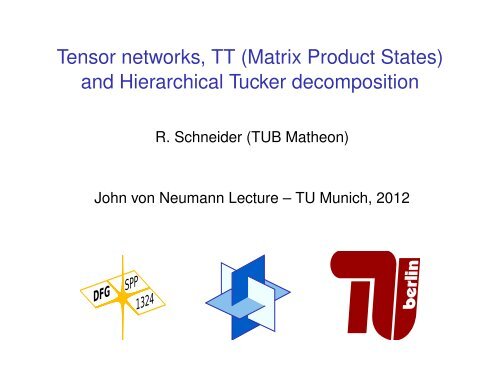
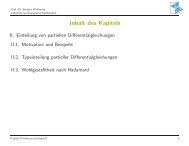
![Vergleich Gradientenverfahren und CG-Verfahren A = [4 0; 0 4] , b ...](https://img.yumpu.com/22549864/1/190x135/vergleich-gradientenverfahren-und-cg-verfahren-a-4-0-0-4-b-.jpg?quality=85)
